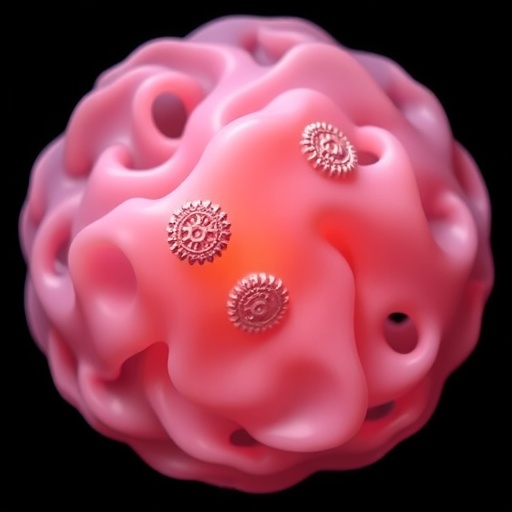A groundbreaking advancement in biomedical engineering has emerged with the development of an innovative ultrasound-guided 3D printing technique that enables the fabrication of medical implants directly within living tissues. This cutting-edge method promises a transformation in personalized medicine by allowing for the creation of custom-tailored therapies delivered precisely to targeted tissue sites deep inside the body. This all occurs without the need for invasive surgical procedures, offering profound implications for patient care, surgical risk reduction, and recovery times.
Current 3D bioprinting technologies have made remarkable strides in generating bespoke implants, complex medical devices, and engineered tissues that correspond closely with individual patient anatomies. Despite their potential, these systems generally require open surgical procedures for implant placement, which introduce risks such as infection, trauma, and prolonged healing. To overcome these obstacles, researchers have been pursuing efforts in in vivo bioprinting, a technique that aims to “print” biological materials directly within the body. However, this approach has faced persistent limitations—chief among them are inadequate tissue penetration depth for printing, a limited selection of bioinks that maintain biocompatibility under physiological conditions, and the challenge of achieving precise, high-resolution control over deposition in real-time.
Addressing these formidable barriers, a team led by Elham Davoodi has engineered an advanced imaging-guided platform termed Imaging-Guided Deep Tissue In Vivo Sound Printing (DISP). DISP utilizes focused ultrasound energy to activate specialized ultrasound-sensitive bioinks, known as US-inks, enabling ultrasound-controlled polymerization and gelation of biomaterials directly inside the body. The bioinks themselves are remarkable composites, integrating biopolymers, imaging contrast agents to facilitate real-time monitoring, and temperature-responsive liposomes loaded with crosslinking agents. These US-inks are administered through minimally invasive routes such as injection or catheter deployment to reach targeted tissues deep beneath the skin’s surface.
A pivotal element of DISP’s success revolves around the focused ultrasound transducer system, which is mechanized using automated positioning informed by a digital blueprint of the desired implant structure. This device generates localized, low-temperature hyperthermia—slightly exceeding normal body temperature—that triggers the release of crosslinkers encapsulated within the temperature-sensitive liposomes, inducing immediate in situ gelation. This ultrasound-triggered polymerization fosters rapid solidification of the biomaterial precisely where it is needed, preserving surrounding healthy tissue and maintaining high spatial precision in three dimensions.
The versatility of the US-inks extends beyond mere structural support. By customizing the chemical composition of these bioinks, researchers can endow the printed hydrogels with a multitude of functionalities. For example, these gels can exhibit electrical conductivity, making them potentially useful for bioelectronic interfaces. They can also be engineered to provide localized, controlled release of therapeutic agents, enabling targeted drug delivery within diseased sites. Additionally, adhesive properties promote tight integration with the host tissue, and the presence of imaging contrast agents allows for ongoing monitoring of the implant’s formation and stability using ultrasound imaging techniques.
Safety and biocompatibility are paramount concerns in any in vivo biomedical application. The research team undertook extensive post-printing analyses which revealed no detectable tissue damage or inflammatory responses following the DISP procedure. Moreover, the unpolymerized US-ink, the fraction of bioink that did not solidify during the ultrasound activation, was effectively cleared by the animal’s natural biological processes within a week. This clearance minimizes the risk of long-term toxicity and further supports DISP’s suitability for clinical translation.
Despite this promising progress, the path to clinical adoption of ultrasound-guided 3D in vivo printing requires additional scientific elucidation and technological refinement. In a complementary Perspective, Xiao Kuang highlights the necessity for detailed investigations into the relationships between processing parameters—such as ultrasound frequency, intensity, and exposure duration—and the resulting microstructure and mechanical properties of the printed biomaterials. Achieving reliable, reproducible fabrication with consistent material properties is essential before DISP-based treatments can be safely and effectively introduced in human patients.
Furthermore, expanding the palette of clinically approved bioinks that respond favorably to ultrasound activation remains an active area of research. Engineering more diverse bioinks with tunable properties involving biodegradability rates, mechanical strength, and multi-functionality will broaden the scope of medical conditions that DISP can address. Likewise, further development of the imaging and targeting software will enhance the precision and user-friendliness of this platform within complex anatomical environments.
The fusion of ultrasound physics, biomaterials science, and advanced biomedical engineering embodied in DISP represents a paradigm shift in regenerative medicine and implantology. This technology paves the way for treatments where implants and therapeutic scaffolds are printed inside the patient’s body on-demand, customized exactly to the defect or diseased area, promoting faster healing and improved clinical outcomes. Its noninvasive nature reduces surgical complications and may enable outpatient or bedside interventions in the future.
In conclusion, Imaging-Guided Deep Tissue In Vivo Sound Printing heralds an exciting frontier in medical bioprinting by overcoming previous limitations related to tissue penetration and bioink compatibility. Through its innovative use of ultrasound-triggered, temperature-sensitive bioinks and real-time imaging guidance, DISP offers unparalleled control over fabricating functional biomaterials deep within live tissues. Continued research and clinical development will be vital in unlocking the full potential of this revolutionary platform to transform how patients receive implants and localized therapies in personalized, minimally invasive ways.
Subject of Research: Ultrasound-Guided In Vivo 3D Bioprinting for Medical Implants
Article Title: Imaging-guided deep tissue in vivo sound printing
News Publication Date: 8-May-2025
Web References: 10.1126/science.adt0293
Keywords: in vivo bioprinting, focused ultrasound, 3D printing, ultrasound-responsive bioinks, medical implants, tissue engineering, drug delivery, real-time imaging, biomaterials, noninvasive surgery, regenerative medicine, bioelectronics
Tags: bioinks for bioprintingbiomedical engineering breakthroughscustom medical implants developmentengineered tissue solutionsin vivo deep-tissue implant fabricationnon-invasive surgical techniquespatient care improvementspersonalized medicine advancementsreal-time deposition control in bioprintingsurgical risk reduction strategiestissue engineering innovationsultrasound-guided 3D bioprinting





